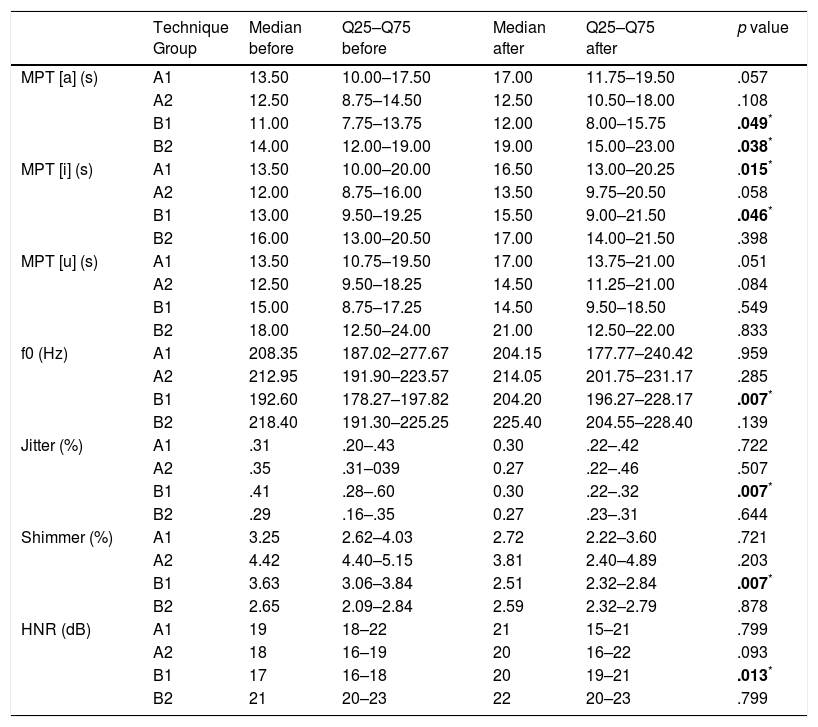Vocal techniques have shown to be important strategies to improve, promote and rehabilitate vocal health.
PurposeVerify the immediate impact of vocal techniques on the improvement of acoustic and aerodynamic parameters, vocal deviation and self-assessment.
MethodsDescriptive, observational, comparative study including 40 women without vocal complaints, age range 18–45 years, equally divided into four groups according to the technique applied. The participants underwent voice assessment before and after performing the vocal technique. Each technique was performed for 1min and participants were re-evaluated in order to measure the immediate effects of the techniques on the parameters evaluated. For the analysis of the variables, the non-parametric Wilcoxon test was used.
ResultsAmong the techniques studied, the high-pitched sound proved more effective in improving the acoustic and perceptual parameters, although in the other techniques was noticed a tendency to improvement in the result, but without statistical significance. In the self-assessment, the techniques to increase the maximum phonation time by softening the emission were more accepted by participants than those related to phonation resistance, which require more effort to be performed.
ConclusionThe high-pitched sound technique favored an improved performance of participants in all parameters evaluated, although the other techniques studied showed a tendency to improvement in the evaluation measures.
Las técnicas vocales han demostrado ser importantes estrategias para mejorar, promover y rehabilitar la salud vocal.
ObjetivoDeterminar el efecto inmediato de técnicas vocales en la mejora de los parámetros acústicos y aerodinámicos de la voz, la desviación vocal y la autoevaluación.
MetodologíaEstudio descriptivo y observacional comparativo. El estudio incluyó a 40 mujeres sin quejas vocales, con edades comprendidas entre 18 y 45 años, igualmente divididas en 4 grupos, de acuerdo con la técnica dada. Las participantes fueron sometidas a evaluación vocal antes y después de la ejecución de la técnica vocal. Cada técnica fue dada por el tiempo de un minuto, y las participantes fueron re-evaluados con el fin de medir el impacto inmediato de las técnicas en los parámetros evaluados. Para el análisis de las variables de este estudio, se utilizó la prueba no paramétrica de Wilcoxon.
ResultadosEntre las técnicas estudiadas la que produjo mejores resultados fue la del sonido agudo, aunque en las otras técnicas se observó una tendencia a la mejora del resultado, pero sin significación estadística. En la autoevaluación, las técnicas para aumentar el tiempo máximo de fonación mediante el ablandamiento de la emisión fueron más aceptadas por las participantes que las relacionadas con la resistencia a la fonación, que requieren más esfuerzo para ser realizadas.
ConclusiónLa técnica de sonido agudo favoreció un mejor rendimiento de las participantes en todos los parámetros, aunque las otras técnicas estudiadas han mostrado una tendencia a la mejora de las medidas de evaluación.










